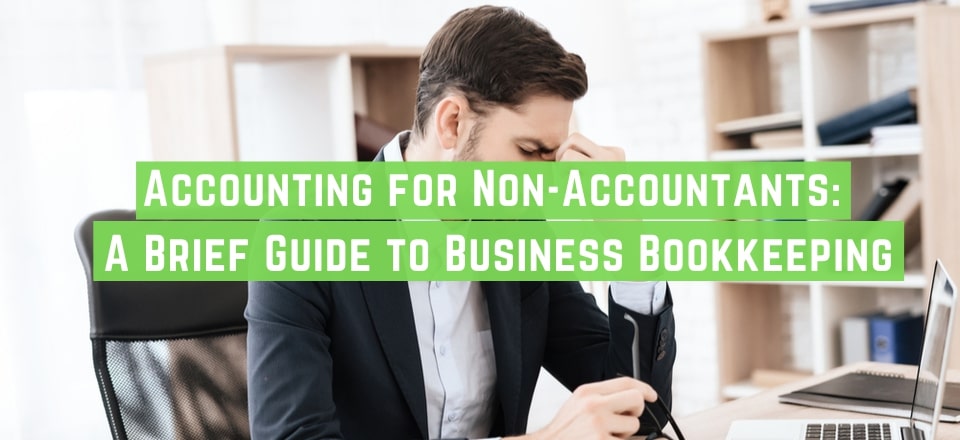Put your hand up if you are involved in running a business in any capacity and wish you better understood the accounting process?
Okay, we can’t actually see your hand, but hopefully, we have your attention!

If you’re one of those business professionals who need some accounting guidance without requiring an accounting degree to understand it, this short guide is for you.
Read on for some straightforward explanations of key accounting terms and principles, such as debits and credits, financial statements, and the different types of revenues and costs that apply to business bookkeeping.
What About Debits and Credits?
Let’s begin by demystifying credits and debits, because it’s a common misconception that they are some kind of opposing entities, like good and evil.
The truth is that credits and debits are opposing entities, but that neither one of them is a good or bad thing. Contrary to popular belief, for instance, debits are not bad, and credits are not good. They are both merely terms used to balance different types of business accounts.

If you have a debit on one account, you will have a corresponding credit on another. That’s one of the primary principles of double-entry bookkeeping.
For example, suppose you sell a product to a customer for $50. You would show the transaction as a debit of $50 on your asset account journal (in the left-hand column of the journal). You would also record a credit of $50 on your revenue account journal (in the right-hand column of the account).
Following the example above, the associated basic entries in the two journals would look like this:
Asset Journal
| Date | Description | Debit | Credit |
| xx/xx/xx | Invoice #001 | $50 |
Revenue Journal
| Date | Description | Debit | Credit |
| xx/xx/xx | Invoice #001 | $50 |
Another fundamental rule worth remembering is that as the value of debits increases, credits decrease correspondingly, and vice versa.
Meanwhile, don’t get fooled into the notion that debits always represent losses and credits represent gains. It all depends on the type of account impacted by the debit or credit.
A debit represents a decrease or loss in liability, equity, and revenue accounts while representing a gain in an asset or expense account. Similarly, a credit represents a loss to expense and asset accounts but represents a gain in a revenue, equity, or liability account.
What About Financial Statements?
If you’re not an accountant but would like to get by with some basic knowledge about business bookkeeping, knowing your credits and debits is only the start.

The next critical element of knowledge would probably be an understanding of three fundamental types of financial statements: the balance sheet, profit & loss statement, and the cash flow statement.
Here we go then, with a brief overview of each of them.
What About the Balance Sheet?

When you need an at-a-glance snapshot of your business’ fiscal status, the balance sheet is your best friend. It shows you the three essential elements of information, which, in combination, summarise your company’s financial position.
Those three elements are:
- Assets (all the things your business owns)
- Liabilities (all your company’s financial obligations)
- Equity (the difference between the value of assets and the value of liabilities)
What About the Profit and Loss Statement?
While the balance sheet is a kind of static financial snapshot, the profit and loss statement shows you how your business has performed financially over a specific period, which might be a month, a quarter, or a year.
The profit and loss statement tracks your revenue (income) gained and costs (expenses) incurred over the period, along with the difference between them, which becomes your business’ profit or loss.
If revenue is greater than cost, the business is in profit, but if the expenses are greater than the revenue for the period, the company has generated a loss.
What About the Cash Flow Statement?
Although the profit and loss statement shows you how much money your business has spent and earned, and the theoretical profits or losses, it’s not necessarily an accurate indicator of how much cash you have available. That’s where the cash flow statement comes in.
The cash flow statement illustrates how, where, and when your business spends or earns cash—with quantification, of course.
As well as recording the cash generated or lost through the business’ operation, the cash flow statement also includes the financial results of investment and financing activities. As such, this statement gives you proper visibility of your company’s cash flow, enabling you to know when, and how much, liquid cash is available.
When looking at cash flow statements, you can find that the flow can be positive or negative. Similar to the debit/credit situation, though, it does not follow that negative cash flow is always bad news or that positive cash flow is good.
For example, positive cash flow might be due to heavy business borrowing, which in many cases can be a sign that things are not going well. Conversely, new businesses sometimes endure several years of negative cash flow before they begin to turn a profit, but that does not necessarily mean they are in financial trouble.
What About Revenue?
You’ll already know that revenue is income if you’ve reached this section in our post. Still, to explain the term in full, we need to emphasise that there are two primary types of revenue—operating revenue and non-operating revenue.

Operating revenue is the income generated by the core activities of your business. So, for example, if your company sells smartphones, the money made from smartphone sales is all operating revenue.
Non-operating revenue is income that your company generates through channels unconnected to core activities.
To return to the example, let’s imagine that your smartphone retail company owns the building in which its headquarters are located. Suppose you decide to rent out some unoccupied office space in that building. The income generated by the rent from your tenants is classified as non-operating revenue.
What About Cost?

In accounting, when we talk about cost, we mean any money that your business spends—your business expenditure. We can break business cost out into several discrete elements, the most important of which are:
- Fixed cost
- Variable cost
- Operating cost
- Direct cost
The following overview of each of these cost types will conclude this brief guide to accounting for non-accountants. It will also complete the basic package of knowledge essential for finding your way around the financial landscape of your business, whether you are the owner, a director, manager, or employee with fiscal responsibility.
What About Fixed Cost?
As the name suggests, a fixed cost is a cost that does not change significantly in the short term and is unaffected by fluctuations in revenue. Examples of fixed costs include rent, salaries, utilities, and insurance. Many fixed cost categories are attributable to the supply of a product or service over a specified period. For instance, rent, salaries, and utility bills are typically payable monthly.
What About Variable Cost?
A variable cost typically fluctuates in line with business activity levels. To highlight this with an example, let’s look at packaging materials. Any enterprise that manufactures a product is likely to use boxes, cartons, or other forms of packaging.

The more products you sell, the more packaging you need. So during periods of peak sales, you will spend more money on the purchase of packaging materials.
Conversely, you will spend less on packaging materials when sales are down. The same is true of the raw materials you use to make your products. Hence, these are variable costs.
What About Operating Cost?
Operating cost is the term that defines all the money that your business spends to enable its day-to-day operations. Whether fixed or variable, any form of expenditure incurred in direct support of the business operation is an operating cost.
Therefore, operating costs can include inventory, raw materials, salaries, utilities, and rent.
On the other hand, costs such as interest payments or capital investment are not operating costs, as the core activities of your business are not directly driving them.
What About Direct Cost?
It’s easy to confuse operating and direct costs because of their mutual association with daily business operations. However, there is a distinct difference between the two.
Direct costs are the expenses necessary to execute the sale of a product—and only those expenses relating to the sale.
For example, if your company pays rent for a warehouse to store inventory, that rent will be payable whether you sell a hundred items or a million. So it is a necessary expense to run your business, and hence, an operating cost, but it is not a cost attributable to a sale, so it’s not a direct cost.
Similarly, you must pay salaries to your staff regardless of how many sales you make, so salaries are not a direct cost, either.
However, the cost of a cardboard carton into which your product is packed is a direct cost because, without the carton, you would be unlikely to sell the product, and if you don’t sell the product, you don’t need to purchase the carton. Because of this relationship with sales activity, many companies refer to direct costs as the cost of goods sold (COGS).
What About Some Help With Your Accounting?
Now that you have read this article in its entirety, you’ve probably amassed a bit more knowledge about business accounting than you possessed a few minutes ago. Such is the power of the written word.

If nothing else, it should enable you to speak some accounting “language”—enough certainly to discuss your business’ finances with a professional bookkeeper.
But what if you don’t have such a professional to help you with your business accounts?
At Virtual Done Well, we have the perfect solution for you. We can provide your business with one or more virtual accounting assistants to take care of your bookkeeping, at shockingly affordable rates, and during the business hours that suit you and your team.
To find out more about hiring and working with a bookkeeping specialist from our stellar accounting team, please check out our accounting services page. Or, if you’re already keen to get started and relieve yourself of a bookkeeping burden, we’re waiting to hear from you, so don’t hesitate to get in touch.



Recent Comments